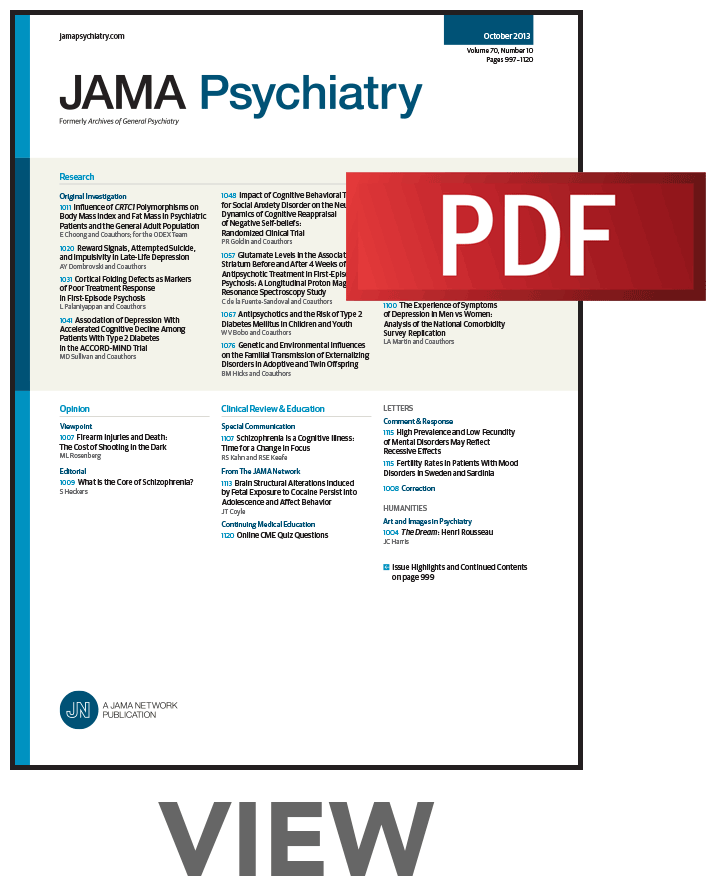Predicting Suicides Among US Army Soldiers After Leaving Active Service.
IF 22.5
1区 医学
Q1 PSYCHIATRY
引用次数: 0
Abstract
Importance The suicide rate of military servicemembers increases sharply after returning to civilian life. Identifying high-risk servicemembers before they leave service could help target preventive interventions. Objective To develop a model based on administrative data for regular US Army soldiers that can predict suicides 1 to 120 months after leaving active service. Design, Setting, and Participants In this prognostic study, a consolidated administrative database was created for all regular US Army soldiers who left service from 2010 through 2019. Machine learning models were trained to predict suicides over the next 1 to 120 months in a random 70% training sample. Validation was implemented in the remaining 30%. Data were analyzed from March 2023 through March 2024. Main outcome and measures The outcome was suicide in the National Death Index. Predictors came from administrative records available before leaving service on sociodemographics, Army career characteristics, psychopathologic risk factors, indicators of physical health, social networks and supports, and stressors. Results Of the 800 579 soldiers in the cohort (84.9% male; median [IQR] age at discharge, 26 [23-33] years), 2084 suicides had occurred as of December 31, 2019 (51.6 per 100 000 person-years). A lasso model assuming consistent slopes over time discriminated as well over all but the shortest risk horizons as more complex stacked generalization ensemble machine learning models. Test sample area under the receiver operating characteristic curve ranged from 0.87 (SE = 0.06) for suicides in the first month after leaving service to 0.72 (SE = 0.003) for suicides over 120 months. The 10% of soldiers with highest predicted risk accounted for between 30.7% (SE = 1.8) and 46.6% (SE = 6.6) of all suicides across horizons. Calibration was for the most part better for the lasso model than the super learner model (both estimated over 120-month horizons.) Net benefit of a model-informed prevention strategy was positive compared with intervene-with-all or intervene-with-none strategies over a range of plausible intervention thresholds. Sociodemographics, Army career characteristics, and psychopathologic risk factors were the most important classes of predictors. Conclusions and relevance These results demonstrated that a model based on administrative variables available at the time of leaving active Army service can predict suicides with meaningful accuracy over the subsequent decade. However, final determination of cost-effectiveness would require information beyond the scope of this report about intervention content, costs, and effects over relevant horizons in relation to the monetary value placed on preventing suicides.预测美军士兵退出现役后的自杀率。
重要性军人回归平民生活后自杀率急剧上升。设计、设置和参与者在这项预后研究中,我们为 2010 年至 2019 年期间退役的所有正规美国陆军士兵创建了一个综合行政数据库。在70%的随机训练样本中,对机器学习模型进行了训练,以预测未来1至120个月内的自杀事件。在其余 30% 的样本中进行验证。主要结果和测量指标结果是国家死亡指数中的自杀。预测因素来自退役前的行政记录,包括社会人口统计学、军队职业特征、精神病理学风险因素、身体健康状况指标、社会网络和支持以及压力因素。结果在队列中的 800 579 名士兵(84.9% 为男性;退役时的中位数 [IQR] 年龄为 26 [23-33] 岁)中,截至 2019 年 12 月 31 日发生了 2084 起自杀事件(每 10 万人年 51.6 起)。假设斜率随时间变化一致的套索模型与更复杂的堆叠泛化集合机器学习模型相比,在除最短风险范围外的所有风险范围内都具有良好的判别能力。接受者操作特征曲线下的测试样本面积从退役后第一个月内自杀的 0.87(SE = 0.06)到 120 个月内自杀的 0.72(SE = 0.003)不等。预测风险最高的 10%的士兵占整个范围内所有自杀人数的 30.7%(SE = 1.8)到 46.6%(SE = 6.6)。与 "全部干预 "或 "不干预 "策略相比,在一系列合理的干预阈值范围内,以模型为依据的预防策略的净收益为正。社会人口学、军队职业特征和精神病理学风险因素是最重要的几类预测因素。这些结果表明,基于离开现役军队时可用的管理变量的模型可以准确预测随后十年的自杀事件。然而,最终确定成本效益需要本报告范围之外的信息,即干预内容、成本和相关时间段内的效果与预防自杀的货币价值之间的关系。
本文章由计算机程序翻译,如有差异,请以英文原文为准。
求助全文
约1分钟内获得全文
求助全文
来源期刊

JAMA Psychiatry
PSYCHIATRY-
CiteScore
30.60
自引率
1.90%
发文量
233
期刊介绍:
JAMA Psychiatry is a global, peer-reviewed journal catering to clinicians, scholars, and research scientists in psychiatry, mental health, behavioral science, and related fields. The Archives of Neurology & Psychiatry originated in 1919, splitting into two journals in 1959: Archives of Neurology and Archives of General Psychiatry. In 2013, these evolved into JAMA Neurology and JAMA Psychiatry, respectively. JAMA Psychiatry is affiliated with the JAMA Network, a group of peer-reviewed medical and specialty publications.
 求助内容:
求助内容: 应助结果提醒方式:
应助结果提醒方式:


